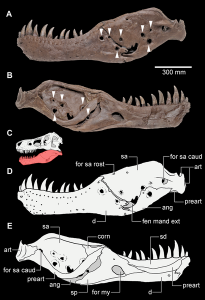Benjamin Franklin quipped that the only thing in this world that is certain is death and taxes. He could have added disease to that list too.
There is a growing body of evidence that many of the diseases that humans and animals suffer from have followed us around from our earliest evolutionary roots. And recognizing disease in fossil animals can tell us a great deal about how the animals lived and give us insight into their everyday lives.
Take for example the well-known dinosaur specimen popularly called “Sue,” one of the most complete Tyrannosaur rex specimens known. Casts of its skeleton have been traveling to museums for many years in the exhibit “A T. rex named Sue,” amazing many people with its size and majesty. In the last weeks of Sue’s life she may have been a very cranky Dame indeed.
Upon viewing her skeleton, many have noticed the unusual holes along her left jaw. Those holes are not normal, but where they a sign of trauma, like wounds from combat? Turns out they are likely from a much small foe than another T. rex.
In a recent article (Wolff et al., 2009) researchers suspect that Sue, and other large carnivorous dinosaurs like her, were plagued by an infection of something like Trichomonas gallinae, a pear-shaped protozoan parasite that today infects birds. The parasite lives in the upper digestive tract of many bird species and causes sores in the mouth and throat. Some of the sores in modern birds have caused bone erosion that looks just like that seen in Sue.
Modern birds transmit the disease through discharge of body fluids. (This parasite does not attack humans). Adult birds that feed offspring can infect them directly for example. Infection is very common in modern birds, and infected birds may have no ill effects. It is not unlikely that in 65 million years of coevolution modern birds have built up resistance to the disease that their ancient cousins, the meat-eating dinosaurs, did not have.
It appears that Sue, and others like her, died of simple starvation, not being able to eat because of mouth and throat sores. An ignoble end perhaps, but showing that this thing we call life can change on the smallest circumstances.
WOLFF, E. D. S., S. W. SALISBURY, J. R. HORNER, AND D. J. VARRICCHIO. 2009. Common Avian Infection Plagued the Tyrant Dinosaurs. Plos One, 4(9):e7288.
Other dinosaur facts can be found here at Boneblogger. Search or select the category for more.
